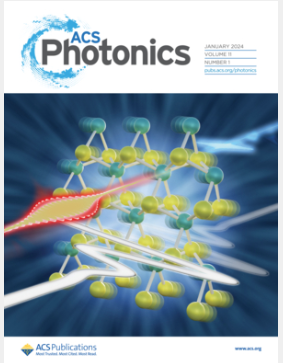In-Plane Excitation of Wedge Plasmon Polariton Modes in a Double Nanohole for Trapping and Sensing Nanoparticles
IF 6.5
1区 物理与天体物理
Q1 MATERIALS SCIENCE, MULTIDISCIPLINARY
引用次数: 0
Abstract
Double nanohole (DNH) optical tweezers with high gradient forces at the cusps have been extensively used to trap and analyze single nanoparticles (NPs), such as DNA and proteins, and their interactions in real-time, without the need for labels or tethers. To excite plasmonic modes in DNHs fabricated on a flat thin gold film, a large-scale free-space optical setup with a well-aligned laser focus is needed. Fabricating DNHs at the fiber’s end removes the need for a bulky microscope setup, but complicates the fabrication process and loses its integrability to realize lab-on-a-chip devices. Here, an integrated DNH-based plasmonic tweezer is proposed in which the wedge plasmon polariton (WPP) modes at the cusps of a DNH are locally excited by a photonic tapered planar waveguide that is compatible with other integrated devices. Numerical results confirm the excitation of WPP modes under certain conditions and a good sensitivity of the transmitted/reflected power in the presence of trapped NPs to optically sense them. Also, comparing the optical forces calculated by Maxwell stress tensor (MST) and point-dipole approximation reveals that the proposed structure benefits from the self-induced back-action (SIBA) effect to trap NPs with lower light intensity. Moreover, due to the different excitation methods, the proposed structure can provide the opportunity to apply an electric field along the DNH’s cusp axis to analyze trapped NPs electrically, apply an electric field during optical measurements, apply dielectrophoresis forces, and integrate miniaturized parallel DNH tweezers with individual operation on a single chip. Numerical simulations give deterministic guidance and potential applications of the proposed excitation scheme to develop integrated DNH-based optical tweezers.

双纳米孔中楔形等离子激元偏振子模式的面内激发,用于捕获和传感纳米颗粒
在尖端具有高梯度力的双纳米孔(DNH)光镊已被广泛用于捕获和分析单纳米粒子(NPs),如DNA和蛋白质,以及它们的实时相互作用,而无需标记或系绳。为了激发在平坦的金薄膜上制造的dnh中的等离子体模式,需要一个具有良好对准激光焦点的大规模自由空间光学装置。在光纤末端制造dnh不需要庞大的显微镜装置,但使制造过程复杂化,并且失去了实现芯片实验室设备的可集成性。本文提出了一种集成的基于DNH的等离子体镊子,其中DNH尖端的楔形等离子体激元(WPP)模式由与其他集成器件兼容的光子锥形平面波导局部激发。数值结果证实了WPP模式在一定条件下被激发,并且在被捕获的NPs存在时,透射/反射功率具有良好的光学灵敏度。此外,比较麦克斯韦应力张量(MST)和点偶极子近似计算的光力,发现该结构得益于自诱导反作用(SIBA)效应,可以在较低光强下捕获NPs。此外,由于不同的激励方法,所提出的结构可以提供沿DNH尖端轴施加电场以电分析捕获的NPs的机会,在光学测量期间施加电场,施加电介质力,并将小型化平行DNH镊子与单个操作集成在单个芯片上。数值模拟为该激励方案的开发提供了确定性指导和潜在的应用前景。
本文章由计算机程序翻译,如有差异,请以英文原文为准。
求助全文
约1分钟内获得全文
求助全文
来源期刊

ACS Photonics
NANOSCIENCE & NANOTECHNOLOGY-MATERIALS SCIENCE, MULTIDISCIPLINARY
CiteScore
11.90
自引率
5.70%
发文量
438
审稿时长
2.3 months
期刊介绍:
Published as soon as accepted and summarized in monthly issues, ACS Photonics will publish Research Articles, Letters, Perspectives, and Reviews, to encompass the full scope of published research in this field.
 求助内容:
求助内容: 应助结果提醒方式:
应助结果提醒方式:


